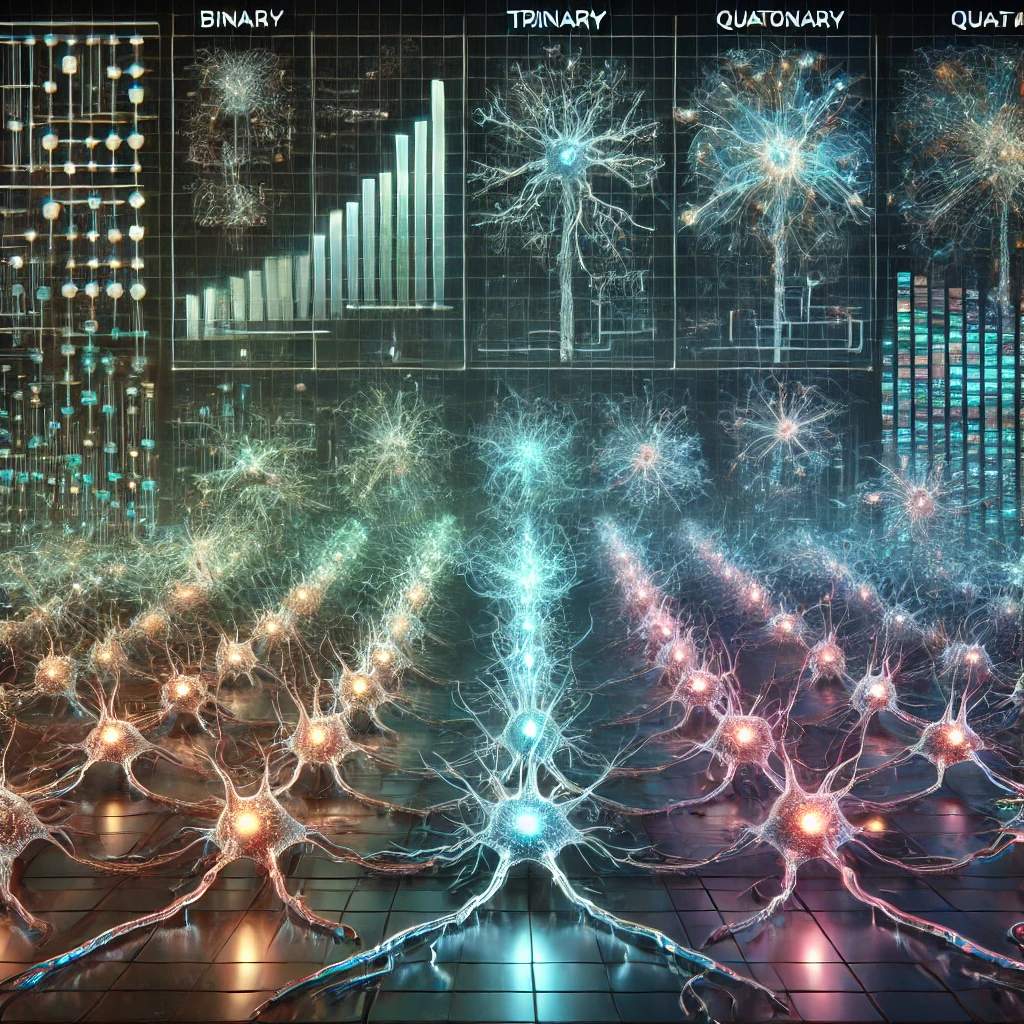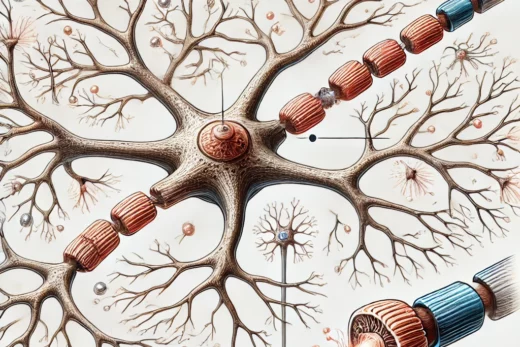
Below is a comprehensive, detailed scientific article that delves into the concepts of binary, trinary, and quaternary states, their implications in both biological and artificial systems, and a breakdown of potential computational gates for each system.
Abstract
This article examines the computational principles of binary, trinary, and quaternary states, exploring their parallels in biological systems (e.g., neural networks) and their potential applications in artificial systems. By analyzing these states’ computational capabilities, advantages, challenges, and possible gate designs, we aim to establish a foundation for understanding multi-state systems’ potential in advanced computation and neuroscience. Additionally, we consider the implications of neurons dynamically switching between these states, proposing mechanisms and applications for such flexibility.
1. Introduction
Computational systems rely on discrete states to encode, process, and transmit information. Traditional binary systems (0 and 1) have served as the foundation of modern computing. However, as technology advances and we seek to model more complex biological processes, such as neural activity, alternative systems like trinary (three states) and quaternary (four states) are gaining attention.
This article is divided into the following sections:
- Explanation of binary, trinary, and quaternary states.
- Biological and computational analogies.
- Advantages, challenges, and applications of each state system.
- Possible gate designs for binary, trinary, and quaternary systems.
- Speculation on neurons dynamically switching between states.
2. State Systems in Computational Frameworks
2.1. Binary States
Binary systems operate on two states: 0 (off) and 1 (on). These states are foundational in digital electronics, where transistors represent either the presence or absence of an electrical charge.
Characteristics:
- State Representation: On/off, true/false, or high/low voltage.
- Gate Design: AND, OR, NOT, NAND, NOR, XOR, and XNOR.
- Applications: Digital logic, arithmetic operations, and memory storage.
Strengths:
- Simplicity in design.
- Energy-efficient for discrete tasks.
- Proven reliability in modern computation.
Weaknesses:
- Limited information density (1 bit per unit).
- Inflexible for tasks requiring complex decision-making.
2.2. Trinary States
Trinary systems introduce a third state, typically represented as -1, 0, and 1 or low, neutral, and high.
Characteristics:
- State Representation: Can include inhibitory (-1), neutral (0), and excitatory (+1) states.
- Gate Design: AND, OR, NOT, MAJORITY, MINORITY, and variants that account for three inputs.
Strengths:
- Higher information density (1.58 bits per unit).
- Natural modeling of systems with excitation, inhibition, and neutrality (e.g., neural networks).
- Enhanced flexibility and decision-making capabilities.
Weaknesses:
- More complex circuitry or biological mechanisms required.
- Higher energy demands compared to binary systems.
2.3. Quaternary States
Quaternary systems extend the logic to four states: 0, 1, 2, and 3 or another analogous representation.
Characteristics:
- State Representation: Four distinct levels, allowing for finer granularity in computation.
- Gate Design: AND, OR, NOT, and multi-value gates that incorporate all four states (e.g., QUAD-AND).
Strengths:
- Even higher information density (2 bits per unit).
- Ability to model systems with greater complexity, such as adaptive neural processes or quantum-like phenomena.
- Greater efficiency in multi-state operations, reducing the number of required components.
Weaknesses:
- Significantly increased design complexity.
- Precision challenges in defining and maintaining distinct states.
- Higher energy consumption relative to binary and trinary systems.
3. Biological Analogies
The human brain exhibits characteristics that resonate with binary, trinary, and quaternary states, depending on how information is processed.
3.1. Binary in the Brain
- Neural Firing: Neurons fire in an all-or-nothing manner, akin to binary states (firing = 1, not firing = 0).
- Synaptic Transmission: Certain neurotransmitter effects are binary, either activating or not activating a post-synaptic neuron.
3.2. Trinary in the Brain
- Excitatory and Inhibitory Signals: Neurons use excitatory (+1) and inhibitory (-1) inputs, alongside neutral resting states (0).
- Neuromodulation: Trinary systems naturally model the balance of excitation and inhibition in networks.
3.3. Quaternary and Beyond
- Neuromodulatory States: Dopamine, serotonin, and other chemicals introduce additional states, potentially quaternary-like, altering network-wide dynamics.
- Plasticity: Changes in synaptic strength represent a higher-order state, influencing memory and learning.
4. Gate Designs for Multi-State Systems
4.1. Binary Gates
- AND: Output is 1 if both inputs are 1.
- OR: Output is 1 if at least one input is 1.
- NOT: Inverts the input (1 → 0, 0 → 1).
4.2. Trinary Gates
- MAJORITY: Outputs the majority state among inputs.
- Example: Inputs (-1, 0, +1); output = 0 (neutral majority).
- INVERT: Flips the state (e.g., -1 → +1, +1 → -1, 0 remains 0).
- THRESHOLD: Outputs +1 if input > threshold, -1 if below, and 0 if neutral.
4.3. Quaternary Gates
- QUAD-AND: Outputs a specific state only if all inputs are identical.
- STATE-SHIFT: Advances input state cyclically (e.g., 0 → 1 → 2 → 3 → 0).
- WEIGHTED AVERAGE: Computes an output state based on weighted input contributions.
5. Neurons Dynamically Flipping States
A neuron capable of switching between binary, trinary, and quaternary modes would redefine computation in biological and artificial systems.
5.1. Mechanisms for State Switching
- Ion Channels: Adjust membrane dynamics to reflect different computational states.
- Neurotransmitter Modulation: Control excitatory, inhibitory, and adaptive states.
- Plasticity: Alter synaptic strengths dynamically.
5.2. Applications
- Adaptive Learning: Adjust neuron states based on task complexity.
- Energy Optimization: Use binary states for simple tasks and quaternary for complex ones.
- Parallel Processing: Combine neurons in different states for hierarchical computation.
6. Implications for Artificial Systems
- Enhanced AI: Multi-state systems allow for more nuanced decision-making and learning.
- Neuromorphic Computing: Mimicking biological state dynamics improves efficiency and adaptability.
7. Conclusion
Exploring binary, trinary, and quaternary states reveals profound implications for both neuroscience and computer science. A neuron or artificial system capable of flipping between these states offers unparalleled flexibility, efficiency, and complexity, paving the way for advanced computation and understanding of intelligence.
References
A detailed list of studies and resources would typically be included here to support the claims and ideas presented in the article.



